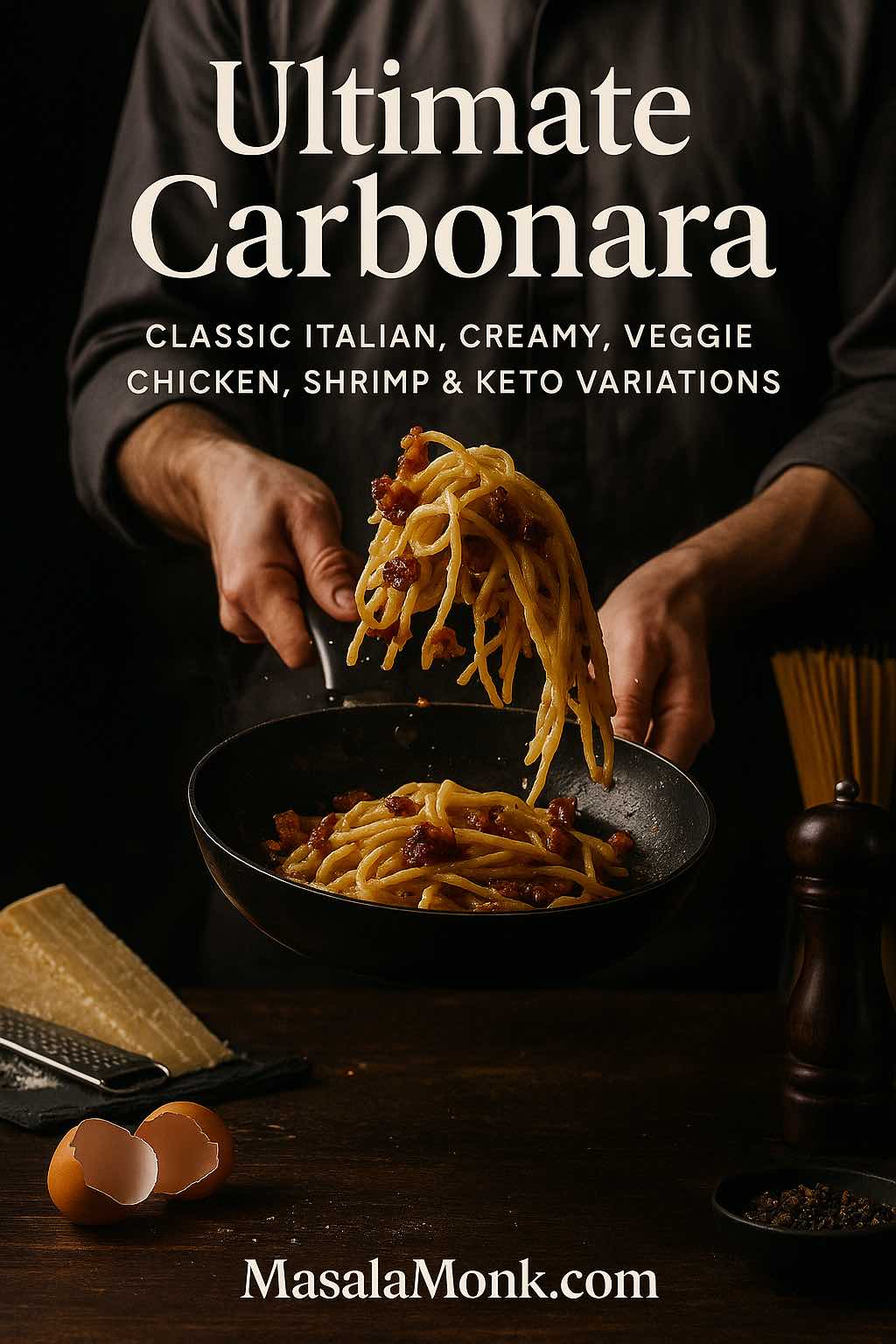
There’s a moment, just after you toss hot pasta through eggs and cheese and pork fat, when everything goes quiet. The noodles glisten, the sauce thickens, and suddenly you’re staring at a bowl of carbonara that looks like it fell out of a tiny Roman kitchen and landed on your table. That’s the magic we’re going for here in this Carbonara Recipe.
This is a complete, reader-first guide to making carbonara at home: starting with a classic, no-cream version, then branching into creamy, veggie, chicken, shrimp, tuna and even keto-friendly twists. Along the way you’ll see a few helpful links—some to deeper technique or ingredient guides on MasalaMonk, others to recipes from sites that specialise in vegetarian or low-carb spins—so you can wander off and explore whatever version fits your mood.
What Carbonara Really Is (And What It Isn’t)
Carbonara is one of those dishes that seems simple until you try to explain it. On paper, it’s almost suspiciously basic: pasta, cured pork, eggs, hard cheese, black pepper. That’s it. Yet when you read through classic Roman versions and careful modern explanations—like the foolproof method in Serious Eats’ spaghetti with carbonara sauce —you start to notice the same core ideas repeated:
- The meat is guanciale (cured pork jowl) or sometimes pancetta, not random ham.
- The cheese is Pecorino Romano, often with a little Parmesan mixed in.
- The “sauce” is an emulsion of egg, grated cheese, pork fat and starchy pasta water.
- There is plenty of black pepper, enough to be noticeable.

Notice what’s missing: cream. Traditional versions rely on the natural richness of egg yolks plus emulsified fat. The creaminess you see on the plate is closer to a glossy custard than a thick white sauce. Guides like the vegetarian carbonara from The Mediterranean Dish also keep that egg-based structure even when they swap out the meat for mushrooms, precisely because that’s what makes carbonara feel like carbonara in the first place.
That said, carbonara is a living dish. Home cooks all over the world slip cream into the mix, use bacon instead of guanciale, add vegetables, throw in chicken or shrimp, stir in a can of tuna, or swap the pasta entirely for zucchini “noodles”. Rather than pretending those versions don’t exist, this guide starts with the most recognisable Roman-style base, then shows you how to bend it in ways that still feel coherent and delicious.
Also Read: 10 Most Popular Mediterranean Breakfasts
Ingredients: The Backbone of a Good Carbonara Recipe
Even before you pick up a knife, good carbonara depends on good ingredients. You don’t need anything fancy, but a couple of choices really change the outcome.
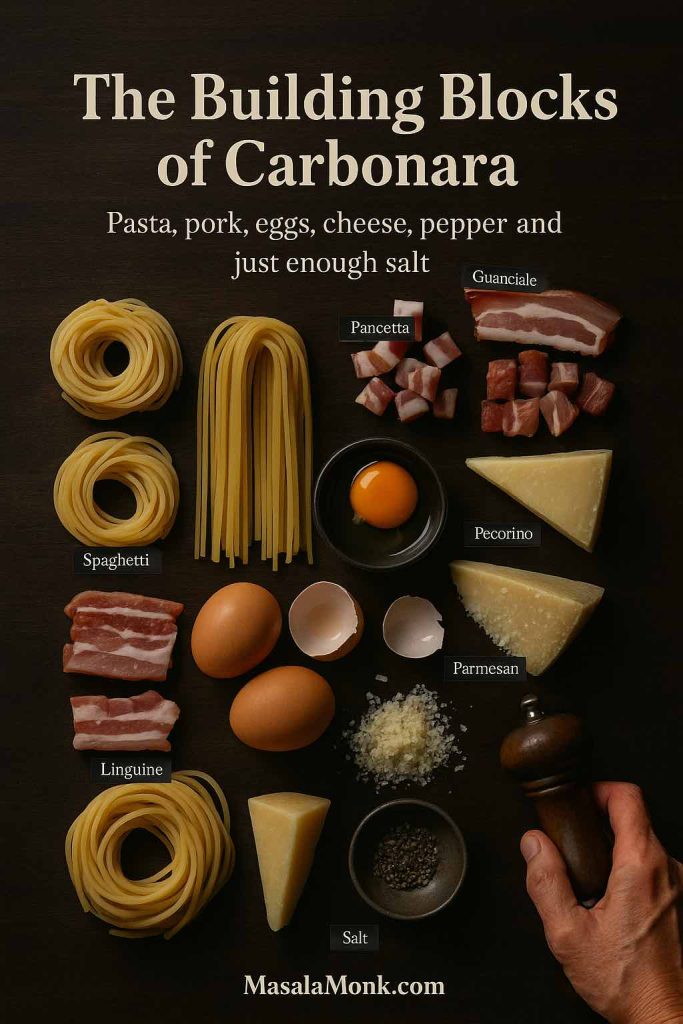
Pasta
Spaghetti is the classic, and it behaves beautifully in this dish. Nonetheless, you can absolutely make excellent carbonara with:
- Bucatini (for an extra-chewy slurp)
- Linguine (a flatter noodle that holds sauce well)
- Fettuccine (if you like something edging toward Alfredo territory)
- Short shapes like penne or rigatoni (great in baked carbonara casseroles)
We’ll circle back to shape choices later, because they’re an easy way to vary your pasta carbonara without changing the core recipe.
Pork
If you can find guanciale, use it at least once; it’s worth it. The fat has a deep, almost floral savouriness that gives everything a distinct Roman character. Pancetta is the next best option, and streaky bacon works perfectly fine for most weeknight bowls.
Cut it into small batons or lardons, rather than tiny bits, so you get a mix of crisp edges and softer, fatty centres.
Eggs
Eggs are the heart of the sauce. Yolks give you richness and that deep yellow colour; whole eggs bring a little extra volume and looseness. A great starting point for two portions is:
- 2 egg yolks + 1 whole egg
You can adjust from there. More yolks make your carbonara deeper and silkier; more whole egg makes it a touch lighter.
Cheese
Pecorino Romano is traditional: it’s salty, sharp and tangy, which cuts beautifully through the richness of pork and egg. Parmesan (or Parmigiano Reggiano) adds nuttiness and a slightly gentler flavour. A lot of home cooks use a mix.
If you enjoy going down cheese rabbit holes, MasalaMonk has a detailed guide to Parmesan cheese and its varieties as well as a helpful comparison of Parmesan and Parmigiano Reggiano with other hard cheeses. Those are worth skimming if you’re choosing cheeses at a well-stocked deli and wondering how far you can stray.
Pepper and Salt
You want freshly cracked black pepper, not the dusty pre-ground stuff at the back of the cupboard. It should be aromatic and obvious in the finished dish—you’re aiming for a gentle pepper heat, not just dots of colour.
Salt mainly lives in the pasta water here. Remember your pork and cheeses are already salty; it’s easy to overdo it if you also heavily season the eggs.
Also Read: 10 Best Espresso Martini Recipe Variations (Bar-Tested)
The Classic Carbonara Method (Step by Step Recipe)
Now that the ingredients are clear, it’s time to build the base recipe. This method works for two generous servings; scaling up is straightforward once you understand the rhythm.
1. Set up your workspace
Before you start cooking, have these ready:
- A large pot for boiling pasta
- A wide, heavy pan (or skillet) for the pork
- A heatproof mixing bowl for eggs and cheese
- Tongs or a pasta fork
- A ladle or measuring cup for pasta water
Lining everything up in advance might feel fussy, yet it makes the most important moment—tossing the pasta with the eggs—much calmer.
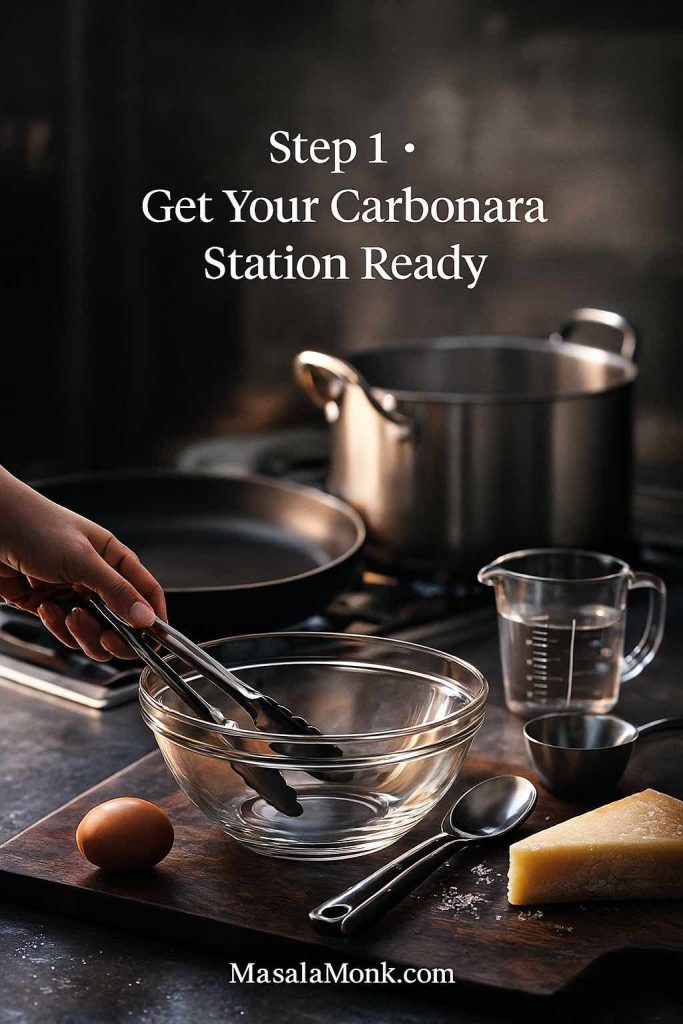
2. Mix the egg and cheese “sauce” for this Recipe of Carbonara
In the heatproof bowl, whisk together:
- 2 egg yolks
- 1 whole egg
- About 60 g finely grated hard cheese, ideally a mix of Pecorino and Parmesan
- A generous pinch of freshly ground black pepper
Whisk until the mixture is smooth and thick, with no streaks of egg white. Set this bowl near the stove; it will be your landing zone for the hot pasta later.
Many detailed recipes, such as the Serious Eats carbonara method, use a sort of double boiler approach to gently warm the egg mixture and guarantee a glossy emulsion. You don’t have to do that, though keeping the bowl near (but not on) the stove naturally warms it a little and helps the sauce come together.
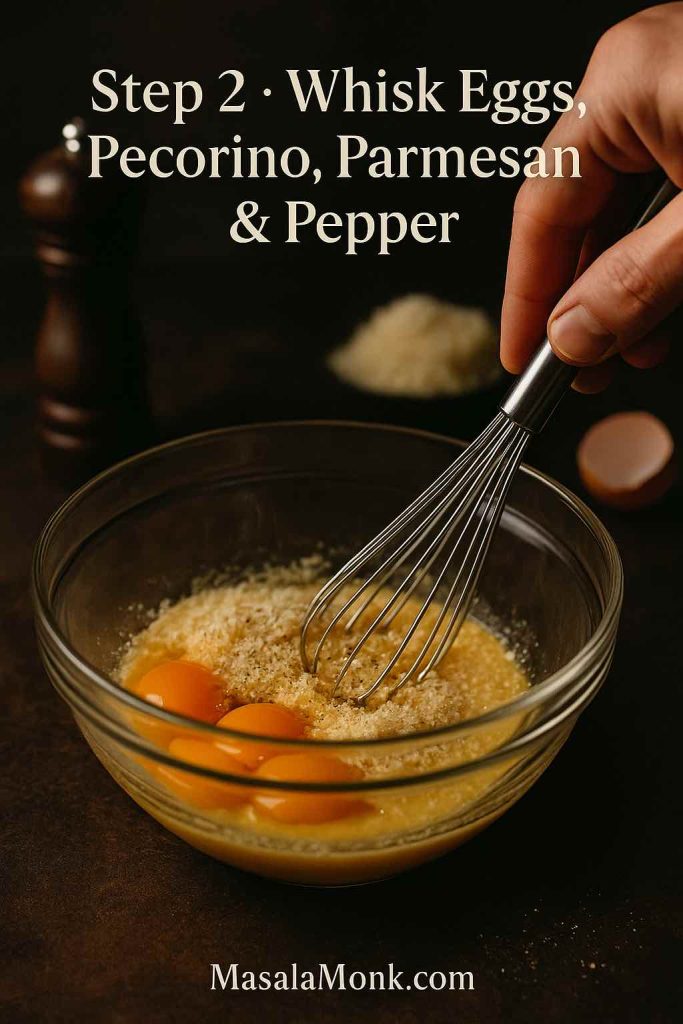
3. Render the pork in Carbonara Recipe
Place the guanciale, pancetta or bacon into a cold pan, then put the pan on medium-low heat. Starting cold gives the fat time to melt out slowly, which both crisps the meat and leaves you with a good amount of flavourful fat to coat the pasta.
Let it sizzle gently, stirring occasionally, until the pieces are golden at the edges and starting to crisp but not rock-hard. Turn off the heat and leave everything in the pan.
At this stage, the kitchen should smell like a trattoria. Try not to eat all the pork out of the pan with your fingers.

4. Cook the pasta
Bring a large pot of well-salted water to a rolling boil. The water should taste pleasantly seasoned, like a mild broth.
Add your spaghetti (or other pasta) and cook until just shy of al dente. While the pasta cooks, stir it from time to time so it doesn’t clump.
A minute or two before the pasta is done, scoop out a good 1–1½ cups of starchy pasta water with a ladle or measuring cup. This step is non-negotiable: that water is crucial to turning your egg-and-cheese mixture into a smooth, pourable sauce.
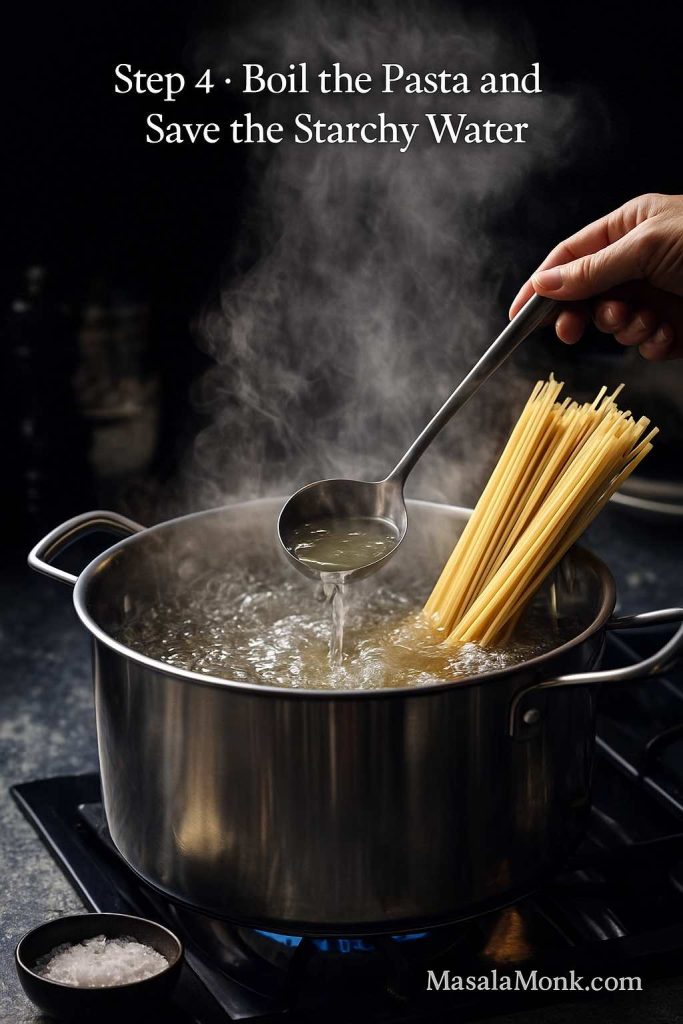
5. Marry pasta and pork
Turn the pork pan back on to low heat and add a small splash of the pasta water. This loosens any sticky bits on the bottom.
Using tongs, transfer the drained pasta straight from the pot into the pan. A little water clinging to the noodles is helpful. Toss the pasta with the pork and its fat for a minute or so, letting the flavours mingle.
Once the pasta looks glossy with fat, turn off the heat completely. This is important; you don’t want the eggs to hit a screaming-hot pan.

6. Emulsify the sauce
Now comes the magic.
Quickly lift the pan and pour the hot pasta and pork into the egg-and-cheese bowl. As you do this, toss constantly with tongs, coating every strand. The residual heat from the pasta will gently thicken the eggs.
Add a small splash of hot pasta water and keep tossing. Then another splash. You’re looking for the sauce to loosen and turn silky enough to cling in a thin, shiny layer rather than clumping.
With a bit of practice, you’ll feel when the balance is right. The noodles should gleam, with no visible streaks of raw egg or puddles of liquid at the bottom of the bowl.
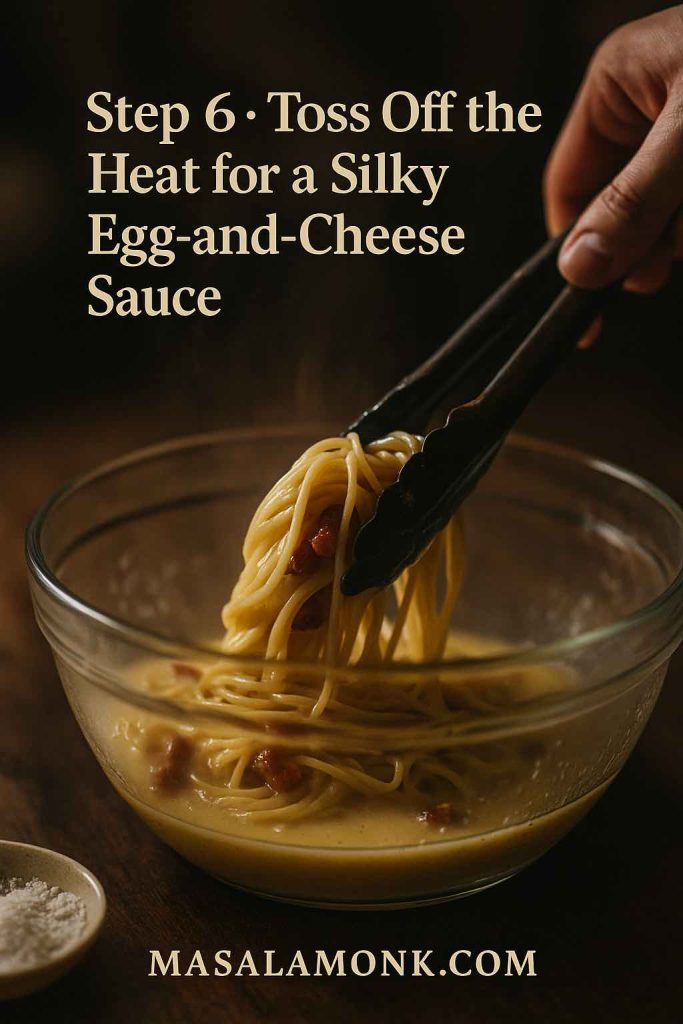
7. Taste and adjust your Carbonara Recipe
Now is the time to fine-tune:
- Add more black pepper if you want extra warmth.
- Grate on a little extra Pecorino or Parmesan for a salty finish.
- If the sauce feels too thick, whisk in another spoonful of hot pasta water.
Serve immediately. Carbonara waits for no one; it keeps cooking in its own heat, and the sauce thickens as it sits.
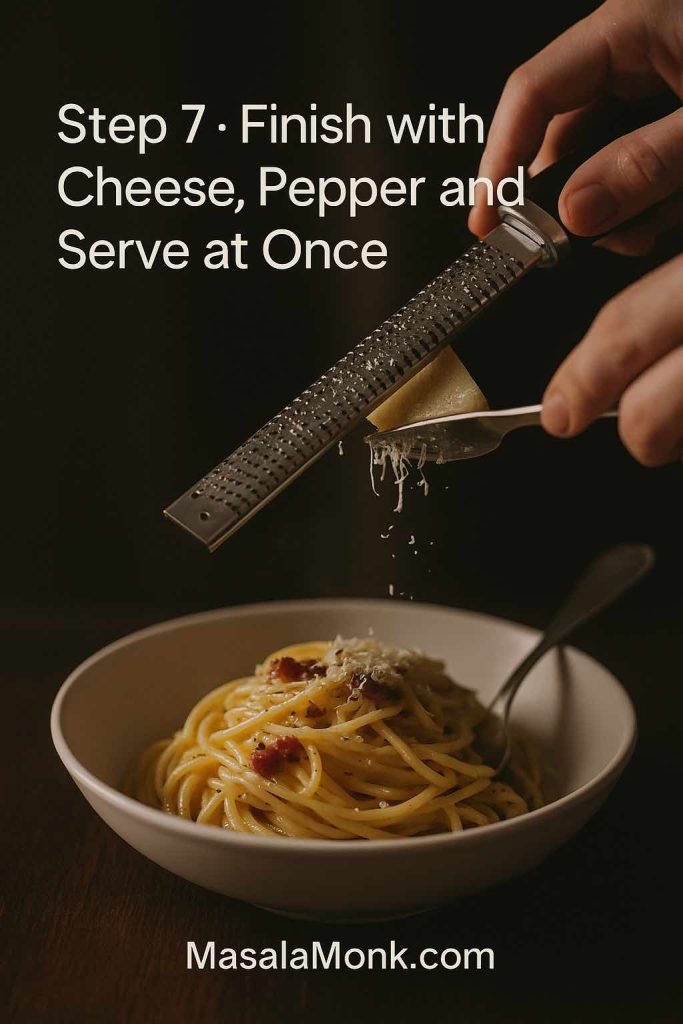
The same basic approach—pork cooked gently, eggs and cheese beaten in a bowl, pasta tossed off the heat with a bit of starchy water—shows up across careful recipes and tutorials, including many “how to” breakdowns on Italian cooking sites and in teaching platforms. Once you’ve done it once, you’ll see why the method doesn’t change much.
Also Read: Cheesy Chicken Broccoli Rice – 4 Ways Recipe (One Pot, Casserole, Crockpot & Instant Pot)
Recipe of Creamy Carbonara (With a Little Cream)
In plenty of Italian kitchens, cream in carbonara is a sacrilege. In plenty of non-Italian kitchens, it’s simply what people grew up eating. If cream is part of your personal comfort bowl, you can absolutely incorporate it gracefully.
The easiest way to do that is to keep the method identical and tweak only the egg mixture.
For two portions:
- Use 2 egg yolks instead of 2 yolks + 1 whole egg.
- Whisk in 60–80 ml of heavy cream or single cream along with the cheese and pepper.
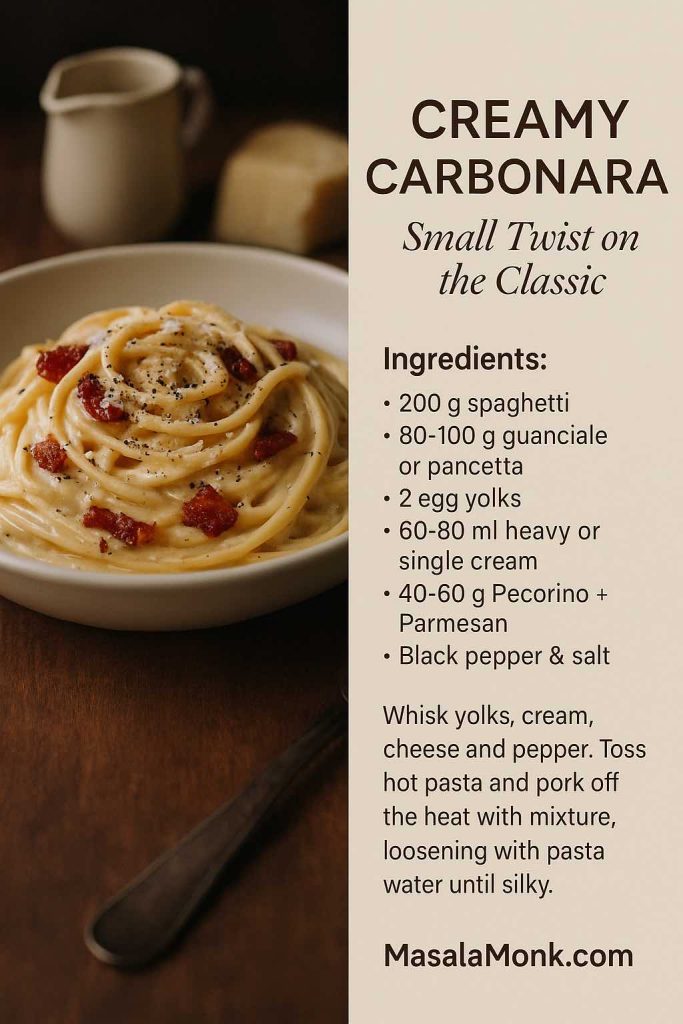
Everything else stays the same: same pork, same pasta, same off-heat tossing with a bit of starchy water. The cream makes the sauce more forgiving and a touch richer, especially when you’re still learning.
If you enjoy comparing different kinds of creamy pasta, MasalaMonk’s collection of chicken Alfredo pasta recipes and their deep dive into classic versus “authentic” Alfredo-style sauces are useful contrasts. They highlight the difference between cream-based white sauces and egg-based emulsions, which helps you understand what’s happening in your own pan.
Vegetarian Carbonara (Recipe With Mushrooms and Veg)
Sometimes you want the comfort of carbonara without the meat. Rather than dumping the eggs and cheese onto plain noodles, it’s worth building a proper vegetarian carbonara that still delivers a savoury hit.
Mushrooms are the natural substitute: they brown, they concentrate, and they bring umami. Courgettes (zucchini) or peas also fit in beautifully, and you can see that approach in dishes like the healthier veggie carbonara at BBC Good Food, which keeps the egg-based sauce but piles on vegetables.
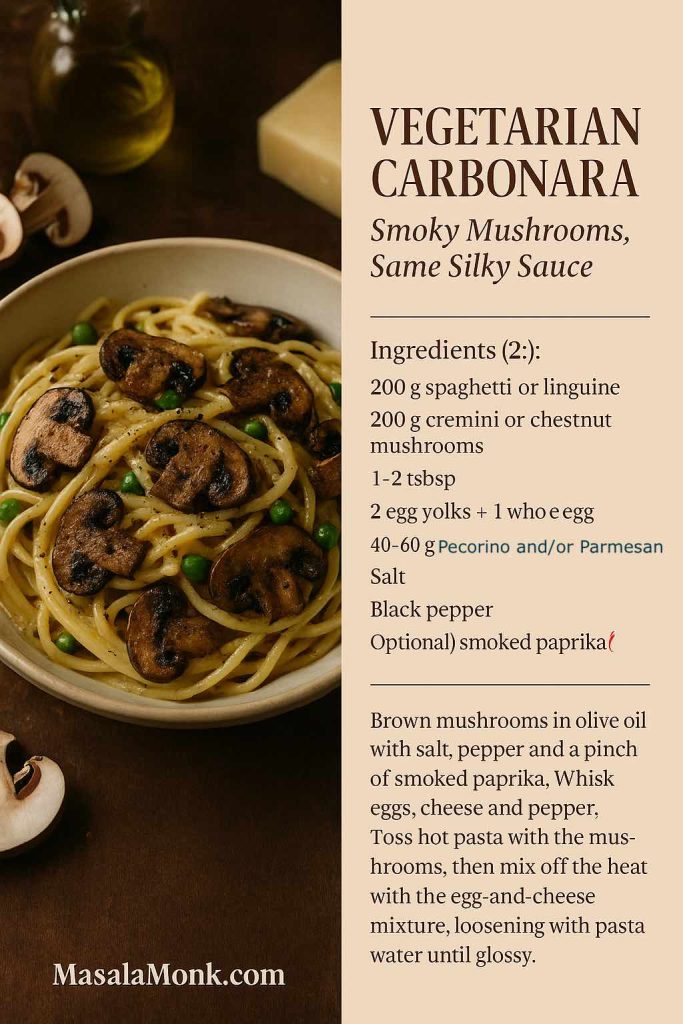
Here’s one way to do it:
- Replace the pork with mushrooms
- Slice 200 g of cremini, chestnut or button mushrooms.
- Add a tablespoon or two of olive oil to your pan.
- Cook the mushrooms over medium-high heat until they are deeply browned and have given up their moisture.
- Season with salt, pepper, and (if you want a faint smoky note) a tiny pinch of smoked paprika.
- Follow the classic method
- Mix eggs and cheese as before.
- Boil the pasta and save your pasta water.
- Toss the hot pasta with the browned mushrooms and their juices instead of pork.
- Transfer everything to the egg bowl and emulsify with splashes of pasta water.
The result is a veggie carbonara that still looks and behaves like the original: creamy, glossy, with a savoury depth that comes from browned mushrooms rather than cured meat.
If you’d like more inspiration, the vegetarian carbonara with smoky mushrooms from The Mediterranean Dish shows a similar idea with extra olive oil and pasta water standing in for pork fat. Meanwhile, for nights when you want to lean more heavily into plant-based eating beyond cheese and egg, MasalaMonk’s collection of high-protein pasta dishes built around lentils and beans gives you additional options that feel hearty but not heavy.
Chicken Carbonara: Protein-Heavy & Crowd-Pleasing Recipe
Chicken sneaks into carbonara in plenty of modern recipes because it makes the dish feel more like a full “meat and pasta” meal, especially if you’re feeding people who expect visible protein on the plate.

To integrate chicken gracefully:
- Cut 150–200 g of boneless chicken thigh or breast into small pieces.
- Season lightly with salt and pepper.
Then:
- Render a small amount of bacon or pancetta in your pan to keep that smoky baseline.
- Scoop the bacon out and set it aside, leaving the fat.
- Sear the chicken pieces in that fat until they’re browned and cooked through.
- Return the bacon to the pan, then proceed as usual when you add the pasta.
When you toss the noodles through the egg mixture, you’ll have a pan full of chicken and bacon pieces waiting to be coated, giving you a bona fide chicken carbonara pasta that still echoes the original dish.
If you like the idea of chicken in a creamy, saucy context, it’s also worth exploring other comfort-pasta territory. MasalaMonk’s one-pot chicken bacon ranch pasta is a great example of how bacon, chicken and cream can play together in a single pan without the egg element, while their macaroni and cheese recipe shows how to build a proper cheese sauce from a different angle entirely.
Shrimp and Seafood Carbonara Recipe
Swapping the pork for shrimp (or using the two together) pushes carbonara in a seafood direction without abandoning the classic egg-and-cheese base.
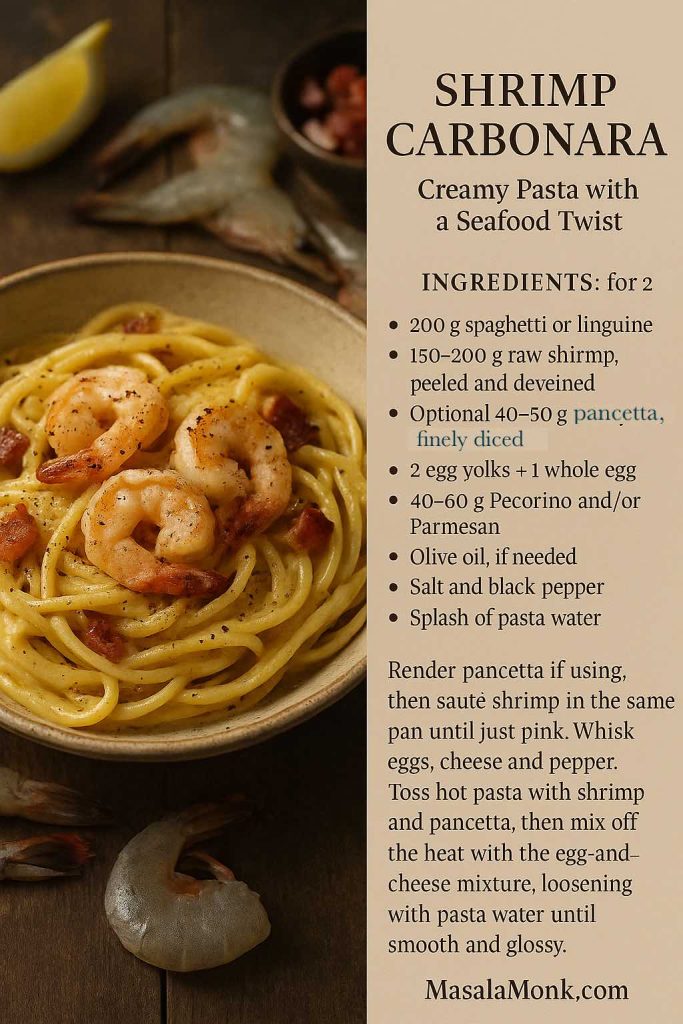
For two servings, you’ll want:
- 150–200 g raw shrimp, peeled and deveined
- Optional: 40–50 g pancetta, finely diced
Here’s how to make it work:
- If using pancetta, render it first just as you would for the classic version. Scoop the bits out and leave the fat in the pan.
- Add a drizzle of olive oil if needed, then sauté the shrimp over medium heat until just pink and barely cooked through.
- Season with a tiny pinch of salt and pepper; remember the cheese will add more salt later.
- Return the pancetta to the pan, add your hot pasta and a splash of pasta water, and toss.
- Tip the whole mixture into the egg-and-cheese bowl and emulsify.
You end up with a shrimp carbonara that still feels like the real dish—egg-based sauce, plenty of cheese, glossy strands of pasta—but accented by sweet bites of seafood instead of, or alongside, the traditional pork.
Also Read: Whole Chicken in Crock Pot Recipe (Slow Cooker “Roast” Chicken with Veggies)
Recipe of Carbonara with Tuna: The Pantry Hero
Tuna doesn’t show up in classic Roman recipes, yet it might be the variation you cook most often simply because everything comes from the cupboard. It’s an especially good answer when you want something that tastes more involved than it actually was.
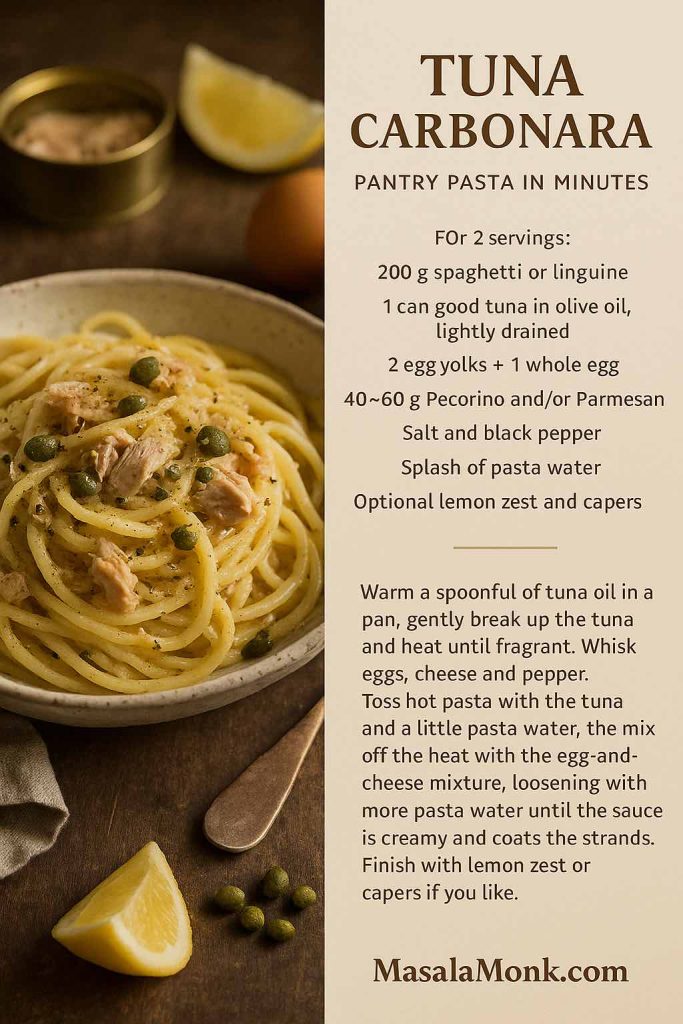
To build a simple tuna carbonara:
- Use the standard egg-and-cheese base.
- Swap the pork for one can of good tuna in olive oil, lightly drained.
Then:
- Warm a spoonful of the tuna oil in your pan.
- Add the tuna and break it up gently over low heat, just until fragrant.
- Toss in your hot pasta and a splash of pasta water; the tuna should coat the strands lightly.
- Move everything to the egg bowl and toss vigorously, adding more pasta water as needed.
You can brighten this variation with a bit of lemon zest or a teaspoon of capers, although you don’t have to. The eggs, cheese and tuna already make a satisfying tuna pasta carbonara without extra embellishment.
Also Read: Authentic Louisiana Red Beans and Rice Recipe (Best Ever)
Keto and Low-Carb Carbonara Recipe with Zucchini Noodles
If you’re eating low-carb or following a keto approach, the main challenge in carbonara isn’t the sauce at all; it’s the pasta. Fortunately, the flavour profile of eggs, cheese, bacon and pepper works beautifully with vegetables like zucchini.
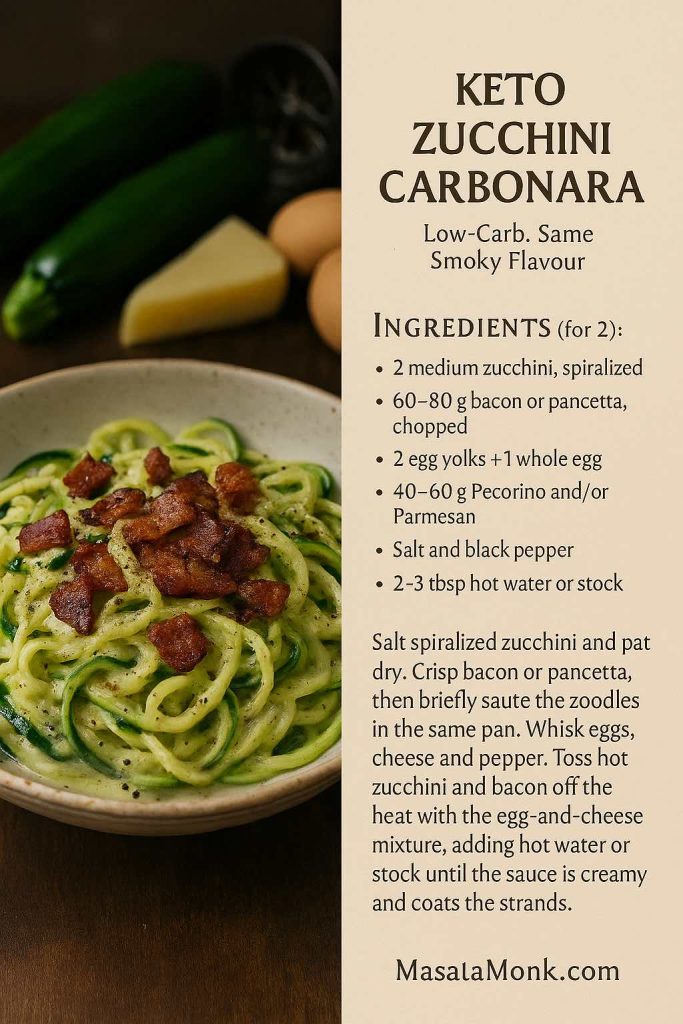
A straightforward path is to replace the spaghetti with spiralised zucchini “noodles”, also known as zoodles. Recipes such as the keto carbonara with zoodles at Diet Doctor show exactly how well that combination can work, keeping the bacon and creamy sauce while ditching the wheat. Likewise, Cooking LSL’s low-carb zucchini carbonara demonstrates a similar idea with courgette strands in place of pasta.
To try a simple version at home:
- Spiralise 2 medium zucchini and salt them lightly. Let them sit in a colander for 10–15 minutes, then pat dry; this removes excess moisture.
- Render your bacon or pancetta in a pan as usual.
- Add the zucchini to the pan and cook briefly—just enough to soften slightly while still keeping some bite.
- Whisk your eggs and cheese in a bowl.
- Transfer the hot zucchini and bacon into the bowl and toss, adding a couple of spoonfuls of hot water (or a splash of stock) to create a creamy coating.
The texture is different, of course; you won’t get the same chew as traditional semolina pasta. Nonetheless, the overall experience—creamy, salty, porky, peppery—lands recognisably in keto carbonara territory.
For days when you’re balancing richer meals with more careful hydration or fasting routines, MasalaMonk’s guide to homemade electrolyte drink recipes is a useful extra resource you can dip into as well.
Playing with Pasta Shapes: Spaghetti, Linguine, Fettuccine, Penne
Once you’re comfortable with the base method, changing the shape of the pasta is an easy way to keep carbonara interesting without rewriting the recipe.
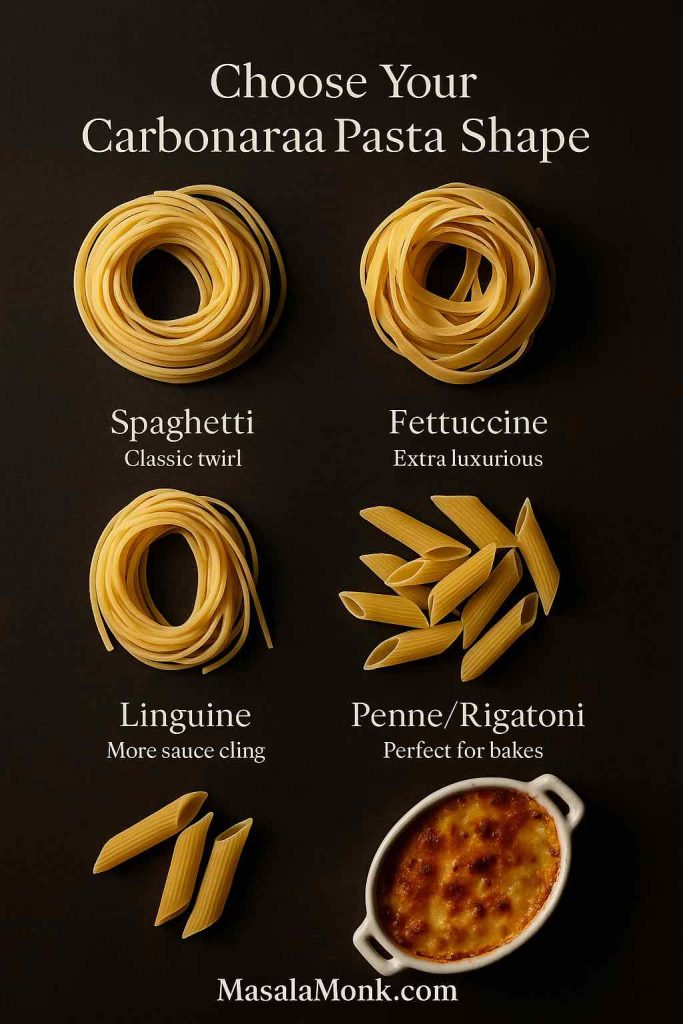
- Spaghetti: the classic; it twirls beautifully and holds just enough sauce.
- Linguine: slightly flatter, gives you more surface area for the sauce to cling to.
- Fettuccine: verges on creamy Alfredo territory, especially in the cream-enhanced version.
- Penne or rigatoni: tubes that capture bits of bacon and pools of sauce inside; wonderful in baked carbonara gratins.
Short shapes are especially good when you want a baked carbonara pasta. You can follow the same egg-and-cheese structure, toss it all together, then slide everything into a buttered dish, sprinkle with extra cheese and bake briefly until the top is just set and lightly browned.
Meanwhile, switching to whole-wheat or legume-based pastas—like chickpea or lentil noodles—can gently tilt your bowl toward higher fibre and protein. For more ideas along those lines, you can look at MasalaMonk’s round-up of high-protein, plant-based pasta meals, which explore exactly that balance.
What to Serve with Carbonara
Carbonara itself is rich and savoury. So, the best companions usually contrast that: fresh, crunchy, tangy or slightly bitter flavours that reset your palate between bites.
A few ideas:
- Simple green salad: toss leaves with lemon juice, olive oil, salt and pepper. The acidity cuts through the sauce nicely.
- Garlicky vegetables: roast or sautéed broccoli, green beans or asparagus with a squeeze of lemon.
- Bread and dips: think toasted sourdough and a dish of something creamy yet lighter than the pasta.

If you enjoy putting sharable starters on the table, MasalaMonk’s collection of spinach dip recipes covers everything from cold, tangy dips to hot, baked ones that sit comfortably next to a carbonara night spread. On the other hand, if you’d like something fresher and more Mediterranean, their Greek tzatziki sauce variations make a cooling side for grilled chicken or vegetables served alongside your pasta.
For dessert, you don’t have to do anything complicated. Fruit and a little whipped cream, a scoop of gelato, or even just a square of good dark chocolate with coffee is often enough after such a rich main.
Also Read: How to Make Churros (Authentic + Easy Recipe)
Leftovers and Reheating
Purists will say carbonara should never see the inside of a fridge. In an ideal world, you would cook exactly the amount you plan to eat and enjoy it all while it’s at its silkiest. Real life is messier, of course, and sometimes you’ll have leftovers.
To store them:
- Let the pasta cool quickly.
- Transfer it to an airtight container.
- Refrigerate for up to 2 days.

Reheating takes a bit of care. Instead of microwaving on full blast (which risks scrambling the eggs), try this:
- Add a spoonful or two of water or milk to a pan over low heat.
- Tip in the leftover carbonara and break up any large clumps.
- Stir gently as it warms, adding another splash of liquid if it seems dry.
The sauce will never be quite as glossy as when it was first tossed, yet you can still coax it into something creamy rather than rubbery. If you like, you can grate over a little fresh cheese and crack some more pepper on top to revive the flavour.
Bringing It All Together
At its core, carbonara is one of the simplest pastas you can make: a handful of ingredients, a single pot of boiling water, and one crucial moment where you toss hot pasta into eggs and cheese and trust the heat to do its work. Once that movement feels familiar, you’re free to adapt:
- Swap cured pork for browned mushrooms and vegetables for a vegetarian carbonara.
- Double down on comfort with a splash of cream.
- Turn it into a more obviously protein-focused meal with chicken or shrimp.
- Raid the cupboard and build dinner around a can of tuna.
- Trade the wheat pasta for zucchini noodles when you’re eating low-carb.
Alongside those variations, you can keep exploring adjacent dishes—whether that’s another creamy pasta from MasalaMonk’s Alfredo and mac-and-cheese repertoire, or low-carb zoodle ideas from places like Diet Doctor and Cooking LSL—to build your own little universe of comfort meals.
However you choose to spin it, once you’ve made this dish a few times, you’ll have more than a recipe. You’ll have a reliable, deeply comforting ritual: boil pasta, crisp something savoury in a pan, whisk eggs and cheese in a bowl, then bring everything together in one quiet, perfect toss.
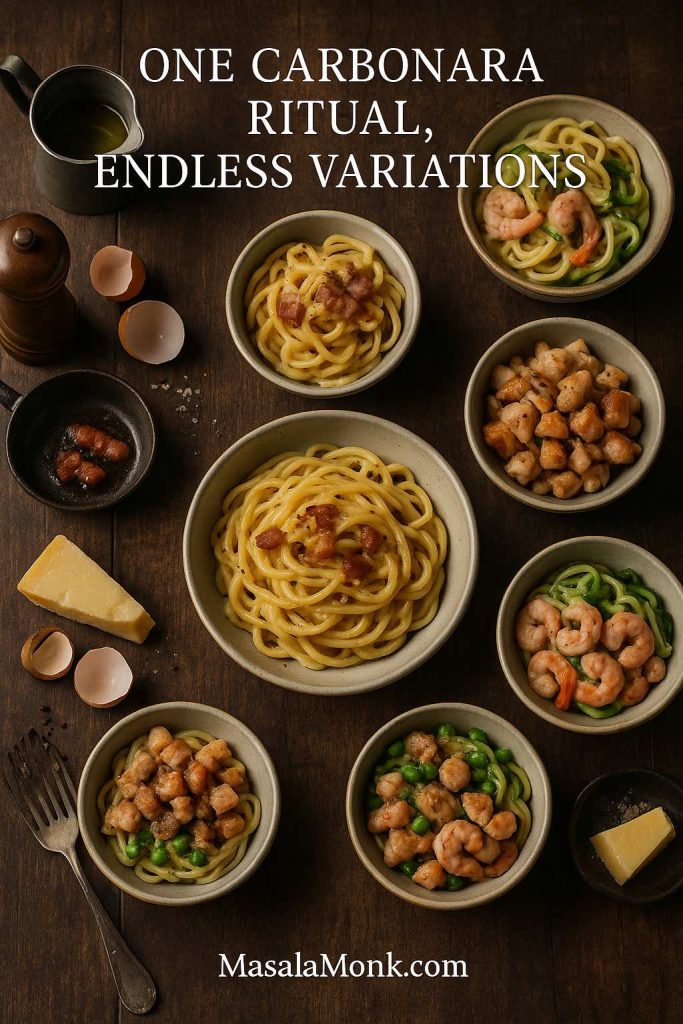
FAQs about Carbonara
1. What are the main ingredients in a traditional carbonara recipe?
A classic carbonara recipe usually includes just a few ingredients: dried pasta (most often spaghetti), guanciale or pancetta, egg yolks, hard cheese such as Pecorino Romano (sometimes with a little Parmesan), freshly ground black pepper and salt for the pasta water. Taken together, these create a rich, glossy sauce without any cream at all. In other words, if you have pasta, cured pork, eggs, cheese and pepper, you already have everything you need for an authentic Italian carbonara.
2. Does real carbonara use cream, or is creamy carbonara always without it?
In traditional pasta carbonara, there is no cream; the creaminess comes from egg yolks, cheese, pork fat and starchy pasta water whisked together into an emulsion. Even so, in many homes around the world people enjoy a creamy carbonara recipe that includes a small splash of cream for extra richness and stability. So, if you want a strictly authentic Italian carbonara recipe, you skip the cream; if you prefer the familiar restaurant-style creamy carbonara, a modest amount of cream can be stirred into the egg-and-cheese mixture without changing the basic method.
3. How do I stop the eggs from scrambling in spaghetti carbonara?
To keep the eggs silky instead of scrambled, the key is temperature control. Firstly, take the pan off the heat before you add the egg mixture; the pasta should be hot, but there should be no direct flame underneath. Secondly, whisk the eggs with cheese in a separate bowl, then add the hot pasta and pork into that bowl and toss constantly. Thirdly, pour in small splashes of hot pasta water as you stir, which loosens the mixture and helps the sauce coat each strand. When you treat the sauce gently like this, spaghetti carbonara becomes creamy and glossy rather than clumpy or eggy.
4. What’s the difference between carbonara and Alfredo pasta?
Although both dishes feel rich and comforting, they are built quite differently. Traditional carbonara sauce ingredients are eggs, hard cheese, cured pork, pepper and pasta water; the sauce is created by emulsifying these together off the heat. Conversely, Alfredo is usually based on butter, cream and cheese, sometimes with garlic or herbs, and often contains no egg at all. Therefore a pasta Alfredo recipe is a cream sauce that simmers on the stove, whereas an authentic spaghetti carbonara recipe is an egg-and-cheese emulsion that thickens only when it comes into contact with hot pasta.
5. Which pasta shape is best for pasta carbonara?
Spaghetti is the most common choice and works beautifully for almost every carbonara recipe. Nevertheless, other shapes also behave well: linguine gives slightly more surface area for the sauce; fettuccine feels luxurious, especially in a creamy carbonara recipe; and short shapes like penne or rigatoni trap sauce and tiny pieces of pork inside their tubes. Ultimately, any pasta that holds the sauce and cooks to a pleasant bite can be used, so you can alternate between spaghetti carbonara, linguine carbonara and penne carbonara depending on what you have in the pantry.
6. Can I make a simple carbonara recipe without pork or bacon?
Yes, you can absolutely prepare a simple carbonara recipe without pork, although the flavour profile changes. Instead of guanciale or bacon, you can brown mushrooms in olive oil until they are deeply golden, then use them as the savoury base for a vegetarian carbonara. Likewise, you might add peas, courgette or spinach for extra colour and texture. Because the egg-and-cheese sauce remains the same, pasta carbonara vegetarian versions still feel creamy and satisfying even when they contain no meat at all.
7. Is there a good vegetarian or veggie carbonara option?
There are several. A popular approach is to build a veggie carbonara with mushrooms, onions and a generous amount of black pepper, then fold in the usual egg and cheese mixture off the heat. Additionally, you can create a spaghetti carbonara vegetarian dish by using olive oil in place of pork fat, adding grilled or roasted vegetables and finishing with Pecorino or Parmesan as usual. For those who prefer a lighter plate, pasta carbonara vegetarian recipes often include extra greens like peas or kale, turning the bowl into a full vegetable-and-pasta meal rather than just a sauce replacement.
8. How can I make an easy chicken carbonara recipe?
For an easy chicken carbonara recipe, you simply add small pieces of chicken to the standard method. Sear bite-sized chunks of chicken breast or thigh in a little oil or in the rendered fat from a small amount of bacon, then set them aside while you cook the pasta. Afterward, return the chicken (and bacon, if using) to the pan, toss with the hot pasta and then combine everything with the egg-and-cheese mixture off the heat. As a result, you get a chicken carbonara pasta that keeps the silky sauce of classic spaghetti carbonara but delivers extra protein and chew in every forkful.
9. How do I adapt carbonara for shrimp or seafood?
To adapt the dish for shrimp, you cook peeled shrimp quickly in a little olive oil or bacon fat until just pink, then follow the usual carbonara steps. After the pasta is cooked, you toss it with the shrimp, add a ladle of hot pasta water and finally fold everything into the egg-and-cheese mixture. In this way, shrimp carbonara (or a broader seafood carbonara) keeps the creamy sauce and peppery bite of the original pasta carbonara while swapping the pork flavour for the sweetness of shellfish.
10. Can I make carbonara without egg, or is egg always essential?
Egg is the core of a traditional carbonara recipe; it provides both richness and structure, so a classic pasta carbonara without egg is no longer really carbonara in the strict sense. That said, there are creamy pasta dishes inspired by carbonara that use cream, cheese and starchy cooking water to imitate the texture while omitting egg entirely, which can be useful for people with allergies. In that case, you would still cook bacon or mushrooms, stir in cream and cheese, and toss with pasta water until the sauce is silky, even though it becomes more of a carbonara-style cream pasta than a true carbonara.
11. What cheese is best for spaghetti carbonara, and can I mix different cheeses?
Pecorino Romano is the classic choice for spaghetti carbonara because it’s salty, tangy and assertive enough to cut through the richness of the egg and pork. Nevertheless, many home cooks like to add some Parmesan or Parmigiano Reggiano for extra nuttiness and a slightly milder edge. Generally, a mix works very well: for example, you might use two-thirds Pecorino and one-third Parmesan in your carbonara sauce recipe. Provided the cheese is hard, dry and finely grated, it will melt smoothly into the egg mixture and help form a stable sauce.
12. How can I make a lighter or healthier carbonara recipe?
A healthier carbonara recipe doesn’t have to sacrifice comfort. One option is to use a smaller amount of bacon or pancetta, focusing on crisp texture and flavour rather than large chunks. Another possibility is to combine whole-wheat or legume-based pasta with plenty of vegetables, turning the dish into a high-fibre, high-protein pasta carbonara. Furthermore, you can favour extra egg whites over yolks to decrease fat slightly while maintaining body in the sauce. Paired with a crisp salad or steamed greens, this style of carbonara feels indulgent but more balanced.
13. Is keto carbonara possible, and what can I use instead of regular pasta?
Keto carbonara is very achievable, since the sauce ingredients—eggs, cheese, bacon and pepper—are naturally low in carbohydrates. The main change lies in the “pasta”. Many people spiralise zucchini into zoodles and treat them as a stand-in for spaghetti, while others use hearts-of-palm noodles or other low-carb alternatives. After you cook the courgette strands briefly in bacon fat, you simply toss them with the egg-and-cheese mixture and a spoonful of hot water, exactly as you would with wheat pasta. Consequently, keto carbonara with zucchini noodles offers the same savoury, creamy flavours in a carb-conscious format.
14. Why is my carbonara dry or clumpy instead of smooth and glossy?
A dry or clumpy carbonara usually signals either too little liquid or too much heat. If you don’t add enough hot pasta water when you toss the pasta with the egg mixture, the sauce can seize and cling in thick patches rather than forming a thin coating. Also, if the pan or bowl is too hot, the eggs can overcook and turn grainy. To prevent this, remove the pan from direct heat, transfer the pasta immediately into the egg bowl, and gradually add hot water while you stir. By adjusting the consistency little by little, you can rescue a stiff sauce and turn it into the smooth, shiny carbonara you’re aiming for.
15. How long does carbonara last, and can I reheat it safely?
Carbonara is best eaten fresh, yet it can be stored for a short time. Typically, leftover pasta carbonara keeps for up to two days in the fridge if you cool it quickly and seal it in an airtight container. When reheating, gentle heat is crucial; otherwise, the eggs can scramble and the sauce may become oily. A practical method is to warm a splash of water or milk in a pan over low heat, then add the cold carbonara and stir constantly until it loosens and heats through. Although the texture won’t be identical to a freshly made spaghetti carbonara recipe, it will still be tasty and comforting enough for a quick lunch.









